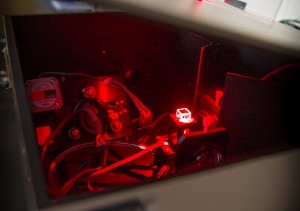Oct 5 2013
UB researcher Jonathan Lovell has received a five-year, $1.9 million grant from the National Institutes of Health to work on a new nanotechnology that could greatly improve how doctors treat and understand cancer.
 When the nanoballoons reach the cancer cells, Jonathan Lovell hits them with a red laser (above), which triggers them to pop open and release the drugs directly at the cancer site. (Photo: Douglas Levere)
When the nanoballoons reach the cancer cells, Jonathan Lovell hits them with a red laser (above), which triggers them to pop open and release the drugs directly at the cancer site. (Photo: Douglas Levere)
The grant is one of 15 awarded nationwide under NIH’s Early Independence Award program that funds high-risk, high-reward research. It helps position UB, which has nationally ranked schools in engineering and medicine, as well as a longstanding partnership with Roswell Park Cancer Institute, at the forefront of cancer research.
“This award will enable UB to continue what it does best: conduct groundbreaking research that serves society while educating the leaders of tomorrow,” says Liesl Folks, dean of the School of Engineering and Applied Sciences. “Specifically, it could help improve how we treat cancer and potentially alleviate pain that millions of people and their families endure.”
Michael Cain, vice president for health sciences and dean of the School of Medicine and Biomedical Sciences, says the grant serves as recognition of the university’s commitment to develop a world-class, cross-disciplinary biomedical research community that is focused on tackling medicine’s most complex and pressing issues.
“The grant is a clear indication that UB’s long-term strategic plan to invest in biomedical research is working,” he says. “Biomedical engineering is a growing field that promises to not only answer critical scientific and medical issues that affect our quality of life, but also underpin the region’s dynamic medical devices economy.”
The new nanotechnology is a drug-delivery method. It centers on the use of nanoballoons, which Lovell, assistant professor of biomedical engineering, describes as “tiny submarine-like vessels that, when struck by a laser, can deliver super-concentrated doses of chemotherapeutic drugs to cancer cells.”
Typically, chemotherapeutic drugs, such as doxorubicin and epirubicin, are delivered intravenously. They spread throughout the body and, as a result, are usually diluted when they reach cancer cells. As the drugs travel, they also interact with bone marrow, blood and other body systems. This often leads to immunosuppression, anemia, hair loss and other unwanted side effects.
Lovell inserts anti-cancer drugs into the nanoballoons, which are made of the organic compound porphyrin and phospholipid, a fat similar to vegetable oil. Roughly 10,000 times thinner than human hair, the nanoballoons encapsulate the drugs to reduce some of the side effects.
When the nanoballoons reach the cancer cells, Lovell hits the nanoballoons with a red laser that triggers them to pop open and release the drugs directly at the cancer site. As the laser is turned off, the nanoballoons close, taking in proteins and molecules that might induce cancer growth and spread. Doctors then would retrieve the nanoballoons by drawing blood or taking a biopsy.
Thus, the nanotechnology could provide a “chemical snapshot” of the tumor’s environment that otherwise would be very difficult to assess.
“Think of it this way,” Lovell explains. “The nanoballoon is a submarine. The drug is the cargo. We use a laser to open the submarine door, which releases the drug. We close the door by turning the laser off. We then retrieve the submarine as it circulates through the bloodstream.”
Lovell has proved the concept in test tubes. He will continue to refine it and, within a year or so, begin testing on animals. Human trials could start within five years.
The work is an example of why UB, with the financial support of the John R. Oishei Foundation, launched in 2008 its Department of Biomedical Engineering, a joint effort between its medical and engineering schools. This fall, the department enrolled 217 undergraduates and 29 graduate students.
“It’s one of the fastest growing and vibrant fields of research,” notes Albert Titus, professor and chair of UB’s biomedical engineering department. “And the demand for students with biomedical engineering backgrounds continues to increase in Buffalo and nationwide.”